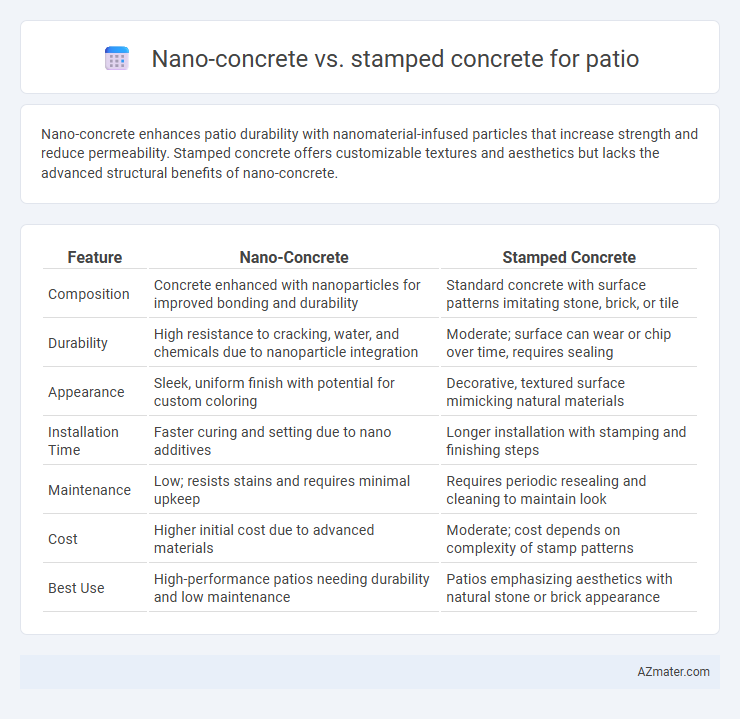Nano-concrete enhances patio durability with nanomaterial-infused particles that increase strength and reduce permeability. Stamped concrete offers customizable textures and aesthetics but lacks the advanced structural benefits of nano-concrete.
Table of Comparison
| Feature | Nano-Concrete | Stamped Concrete |
|---|---|---|
| Composition | Concrete enhanced with nanoparticles for improved bonding and durability | Standard concrete with surface patterns imitating stone, brick, or tile |
| Durability | High resistance to cracking, water, and chemicals due to nanoparticle integration | Moderate; surface can wear or chip over time, requires sealing |
| Appearance | Sleek, uniform finish with potential for custom coloring | Decorative, textured surface mimicking natural materials |
| Installation Time | Faster curing and setting due to nano additives | Longer installation with stamping and finishing steps |
| Maintenance | Low; resists stains and requires minimal upkeep | Requires periodic resealing and cleaning to maintain look |
| Cost | Higher initial cost due to advanced materials | Moderate; cost depends on complexity of stamp patterns |
| Best Use | High-performance patios needing durability and low maintenance | Patios emphasizing aesthetics with natural stone or brick appearance |
Introduction to Nano-concrete and Stamped Concrete
Nano-concrete incorporates nanoparticles to enhance durability, strength, and resistance to environmental factors, making it an advanced material option for patio construction. Stamped concrete mimics the appearance of natural stone, brick, or wood through textured patterns and color variations, offering aesthetic versatility at a lower cost. Both materials provide unique benefits for patios, balancing functionality and design preferences.
Composition and Material Differences
Nano-concrete incorporates nanomaterials like silica nanoparticles, enhancing strength and durability at the molecular level, while stamped concrete primarily uses traditional Portland cement mixed with aggregates and coloring agents. The nanoscale additives in nano-concrete improve bonding and reduce porosity, resulting in a denser matrix compared to stamped concrete's surface-level texturing and pigmentation. These material differences lead to nano-concrete patios offering superior resistance to cracks and environmental wear compared to the aesthetic-focused, patterned finish of stamped concrete.
Installation Process Comparison
Nano-concrete for patios involves the application of ultra-fine nanoparticles that enhance bonding and curing speed, resulting in a durable, crack-resistant surface with minimal preparation. Stamped concrete requires a multi-step process including pouring, leveling, and imprinting detailed patterns into freshly laid concrete, often followed by coloring and sealing to achieve a decorative finish. Installation of nano-concrete is generally faster and less labor-intensive, whereas stamped concrete demands skilled craftsmanship and more time to ensure precise pattern replication and texture quality.
Durability and Longevity
Nano-concrete incorporates nanoparticles that enhance its microstructure, resulting in superior durability and resistance to wear compared to traditional stamped concrete. Stamped concrete, while aesthetically appealing, is prone to cracking and surface wear over time due to its conventional aggregate composition and curing process. Nano-concrete's advanced formulation significantly extends patio longevity by improving resistance to environmental stressors and reducing maintenance needs.
Aesthetic and Customization Options
Nano-concrete offers a sleek, modern aesthetic with enhanced durability and a smooth finish ideal for minimalist patio designs. Stamped concrete provides diverse customization options, replicating natural materials like stone, brick, or wood, adding texture and intricate patterns to accentuate outdoor spaces. Both materials cater to unique stylistic preferences, with nano-concrete favoring contemporary looks and stamped concrete excelling in versatile decorative appeal.
Maintenance Requirements
Nano-concrete requires minimal maintenance due to its enhanced durability and resistance to cracks, stains, and weathering, making it ideal for patios exposed to heavy foot traffic and varying climates. Stamped concrete demands more frequent sealing and cleaning to prevent fading, chipping, and moisture damage, particularly in areas with extreme temperatures or high humidity. Choosing nano-concrete reduces long-term upkeep costs and preserves aesthetic appeal with less effort compared to stamped concrete maintenance.
Cost Analysis and Budget Considerations
Nano-concrete typically involves higher initial material costs due to advanced nanotechnology additives that enhance durability and strength, making it a long-term investment for patios. Stamped concrete offers a more budget-friendly option with lower upfront costs and versatile aesthetic designs, but may require more frequent maintenance and sealing to prevent wear. Homeowners should weigh nano-concrete's longevity and reduced repair expenses against the affordability and customizable appearance of stamped concrete when planning patio budgets.
Environmental Impact and Sustainability
Nano-concrete offers enhanced durability and significantly reduces the need for frequent repairs or replacements, leading to lower carbon emissions over its lifecycle compared to stamped concrete. Stamped concrete, while visually appealing, often requires sealants and chemical treatments that can contribute to environmental pollution and complicate recycling efforts. Choosing nano-concrete for patios supports sustainable construction by minimizing raw material use and improving long-term energy efficiency through better thermal properties.
Slip Resistance and Safety
Nano-concrete offers superior slip resistance for patios due to its enhanced surface texture created by nanoparticles, which increase friction and reduce the risk of slipping when wet. Stamped concrete provides aesthetic appeal but can be less slip-resistant, especially if not treated with anti-slip sealers or additives, making it potentially more hazardous in wet conditions. Choosing nano-concrete ensures a safer patio environment with improved durability against slipping incidents.
Choosing the Best Option for Your Patio
Nano-concrete offers enhanced durability, water resistance, and self-healing properties, making it ideal for patios exposed to heavy weather and frequent use. Stamped concrete provides aesthetic versatility with customizable patterns and textures that mimic natural stone or brick, perfect for decorative outdoor spaces. Choosing the best option depends on balancing long-term performance needs with desired design appeal for your patio environment.

Infographic: Nano-concrete vs Stamped concrete for Patio
 azmater.com
azmater.com